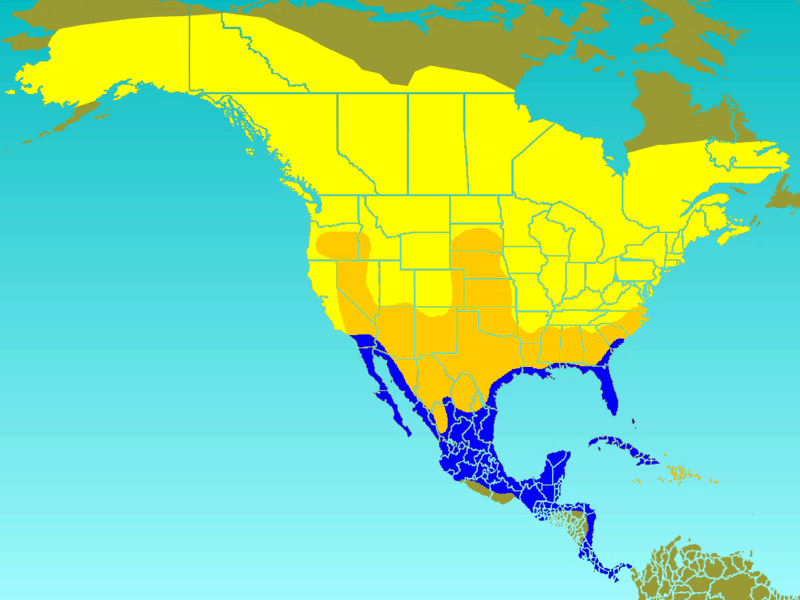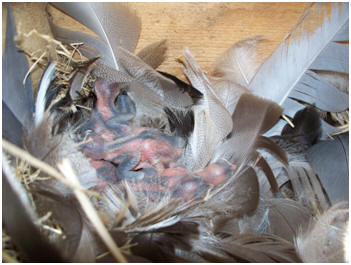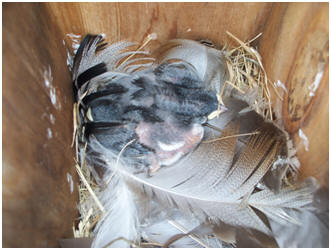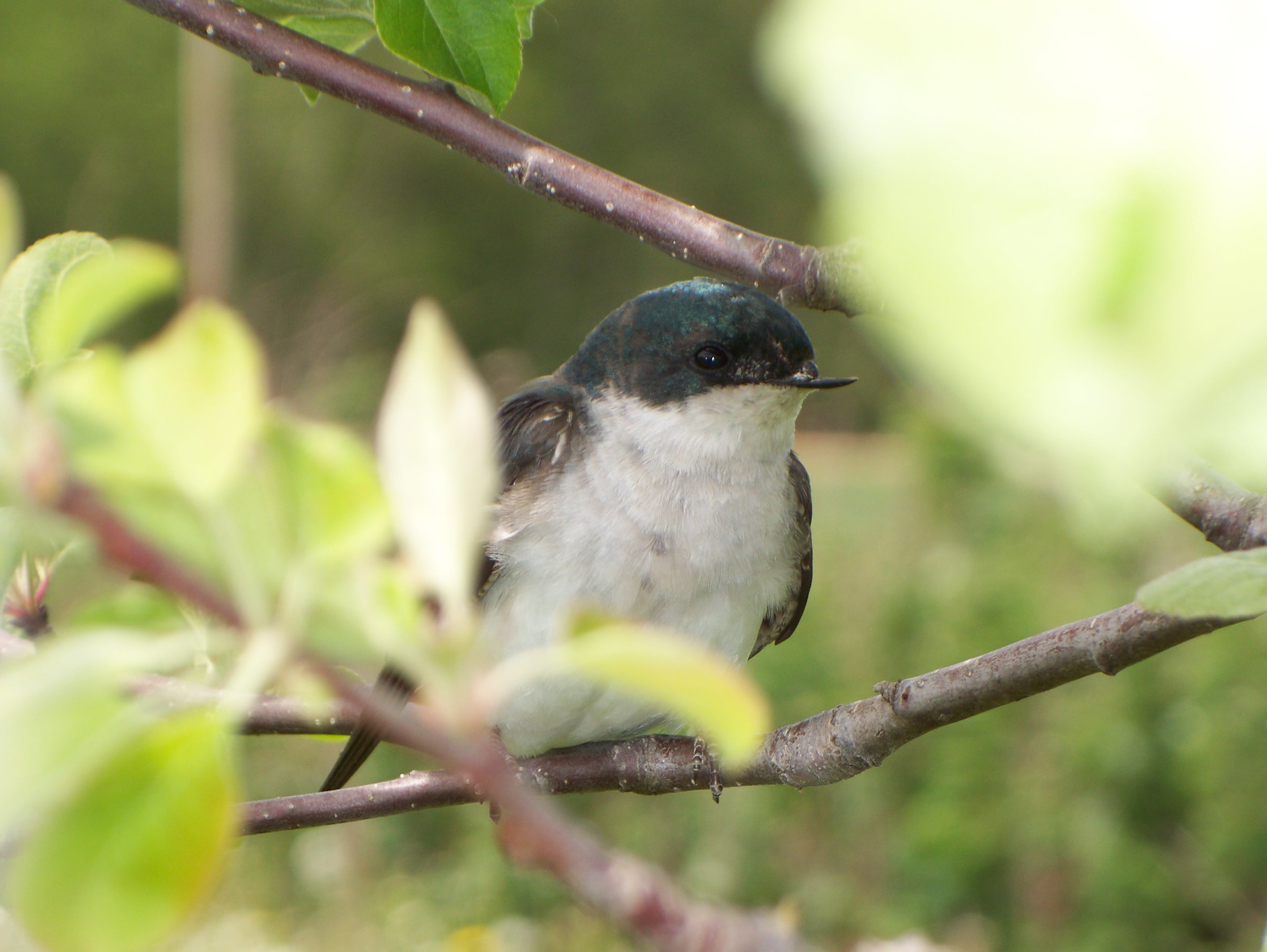General Information
In this section you can learn more about the specifics of
Tree Swallows. Click each heading to learn more about what
you are interested in.

●
Identification
●
General Range/Migration
●
Habitat
●
Diet
●
Reproduction
●
Behavior
●
Voice
Tree Swallows are characterized as being 5 to 6 inche s in length from their
beak to the tip of their forked-tails. As adults, males and females are a
very beautiful color showing a metallic blue with a greenish shade on their back
and wings, with a white underside. Sometimes adult females show a little
bit more of a browner shade than the males, but mostly they cannot be separated. Immature females on the other
hand still have a white belly, but they have a dull
s in length from their
beak to the tip of their forked-tails. As adults, males and females are a
very beautiful color showing a metallic blue with a greenish shade on their back
and wings, with a white underside. Sometimes adult females show a little
bit more of a browner shade than the males, but mostly they cannot be separated. Immature females on the other
hand still have a white belly, but they have a dull
 brown back and wings.
After about one year, sometimes two, these immature females will lose these
feathers and they will be replaced with the color of other adults.
brown back and wings.
After about one year, sometimes two, these immature females will lose these
feathers and they will be replaced with the color of other adults.
The picture above shows an example of an
immature female. You
can see this by its dull brown back. The picture to the right, shows an adult.
It cannot be concluded, however, whether or not it is female or male.
Tree Swallows are generally the first swallow species to move north each
spring. Tree Swallows are drawn to North America in the
spring and summer for breeding as well as for its abundance of food and variety
of nest sites.

In the winter, Tree Swallows spend their time in the southern coasts of the
United States, down in Mexico, and as far south as Central America. During
the spring and summer, they will migrate as far north as Alaska, all across
Canada, and throughout the United States’ Northern states, including Wisconsin.
The map on the side shows perfectly where Tree Swallows are found throughout
the year. Yellow indicates where they are during the summer, blue
indicates where they spend their winters, and orange indicates their migration
range. This species of swallow are common in its range as long as
their appropriate needs are met.
Tree Swallows can be found mostly in fields and
 meadows at the borders of
wetlands, marshes, lakes, and streams. These open areas are near water and
provide great access to many
flying insects that they eat. Tree Swallows would not do well in areas
with many trees because it would pose a problem not only with increased number
of predators, but also would make hunting difficult. Trees create a huge
obstacle for these organisms. Tree Swallows will not hide in the trees when
predators approach because they rely on their ability to fly away. But, if
trees are in the way
they will not be able to easily fly away.
meadows at the borders of
wetlands, marshes, lakes, and streams. These open areas are near water and
provide great access to many
flying insects that they eat. Tree Swallows would not do well in areas
with many trees because it would pose a problem not only with increased number
of predators, but also would make hunting difficult. Trees create a huge
obstacle for these organisms. Tree Swallows will not hide in the trees when
predators approach because they rely on their ability to fly away. But, if
trees are in the way
they will not be able to easily fly away.
 They are often found near humans, especially in places like that found in the
picture. Tree Swallows are found every spring in this location which has many of
the elements in which Tree Swallows find a good habitat.
They are often found near humans, especially in places like that found in the
picture. Tree Swallows are found every spring in this location which has many of
the elements in which Tree Swallows find a good habitat.
Tree Swallows are magnificent and skillful flyers, as well as, talented
hunters chasing flying insects at speeds up to 20 mph. These birds will fly over
land and water catching their meals in midair, like you can see in the picture
on the right.
Tree Swallows can be considered the natural pest controller because they are
known to eat a whole variety of flying insects. These insects include:
flies, grasshoppers, beetles, moths, and dragonflies. They will even enjoy
eating a meal of bees or wasps if they are around.
.jpg)
When insect number becomes scarce, Tree Swallows will survive on seeds and berries if they have to. This type of diet usually occurs right before migration.
Reproduction, Nesting, and Development
Tree Swallows are sexually reproducing organisms. Like most sexually
reproducing organisms, a Tree Swallow’s goal with mating is to pass their genes
onto the next generation. In fact, in some nests, eggs could have come
from multiple fathers. This provides more variety within a
population and a better chance of survival.
Tree Swallows are found to nest in differ ent
types of cavities. Because they cannot make their own cavities they are
usually found nesting in tree cavities, old wood pecker holes, and bird houses.
Some will even nest in open mailboxes. They rely on these existing
cavities because they never make their nests outside of cavities and they cannot
build their own.
ent
types of cavities. Because they cannot make their own cavities they are
usually found nesting in tree cavities, old wood pecker holes, and bird houses.
Some will even nest in open mailboxes. They rely on these existing
cavities because they never make their nests outside of cavities and they cannot
build their own.
Their nest itself is usually made up of accumulated grass or hay lined with
feathers or paper scraps. You can see this in the picture above. The
feathers are from the same species or from other species.
Tree Swallows usually have about 4-6 eggs that are pure white in color. The picture
to the left gives an example of these white eggs. Females will lay only
one per day at the most and will incubate these eggs for approximately 14-16
days. Tree Swallows will have no more than 6 eggs because over that number
it is too many young to care for, should they all survive to hatching.
Swallows usually have about 4-6 eggs that are pure white in color. The picture
to the left gives an example of these white eggs. Females will lay only
one per day at the most and will incubate these eggs for approximately 14-16
days. Tree Swallows will have no more than 6 eggs because over that number
it is too many young to care for, should they all survive to hatching.

The hatched young are altricial, helpless, and unable to move or feed themselves
without help. The picture on the right gives an example of how they look only
three days after hatching.

The new nestlings will develop fast. Within nine to twelve days they are
developing their wings, as can be seen in the picture on the left. At this
point they still rely on their parents to bring them food. They do not
leave the nest for about 3 weeks until their wings are fully developed or until
conditions are favorable. The picture below shows a group of nestlings
about ready to leave the nest.

During each summer, each pair of Tree Swallows will lay eggs approximately one
or two times. So, once the first “batch” hatches, many times the female
will raise another group of babies. This allows for a greater chance of
survival for the entire species.
Besides the magnificent flight of Tree Swallows, catching insects in mid air, the most interesting behavior of these birds is that relating to their pairing during the breeding season. Unlike other swallows that are mostly colonial, Tree Swallows are not. They usually nest in isolated pairs.
Like was already mentioned in Identification,
 immature
females lack the vibrant blue color of the adult males and females. This
is only seen in birds falling under the Order Passerines and those whose range
is in North America. One may think this would not be very important but
these brown colored feathers allow the immature females to approach breeding
adults and their nests without being chased away. These immature females
then can monitor and watch over these breeding pairs and be ready to replace any
adult female that did not survive during the nesting season. This allows a
greater chance survival for the entire species.
immature
females lack the vibrant blue color of the adult males and females. This
is only seen in birds falling under the Order Passerines and those whose range
is in North America. One may think this would not be very important but
these brown colored feathers allow the immature females to approach breeding
adults and their nests without being chased away. These immature females
then can monitor and watch over these breeding pairs and be ready to replace any
adult female that did not survive during the nesting season. This allows a
greater chance survival for the entire species.
Also, another point made previously was that Tree Swallows are usually the first swallows to arrive in the spring. This
occurs because this gives them that greater edge on finding nest sites before
the competition even arrives. This allows the breeding pairs to have more young
in one breeding season. To keep their nests, Tree Swallows are usually
very territorial and will be very aggressive to show their dominance in the
specific territory.
Swallows are usually the first swallows to arrive in the spring. This
occurs because this gives them that greater edge on finding nest sites before
the competition even arrives. This allows the breeding pairs to have more young
in one breeding season. To keep their nests, Tree Swallows are usually
very territorial and will be very aggressive to show their dominance in the
specific territory.
Another important fact about Tree Swallows is that Tree Swallows like places to perch. Through evolution, like many other birds, Tree Swallows were given a three-forward pointing toes and one pointing backward, refer to Adaptation Through Anatomy. Here they are able to rest safely after astonishingly long flights and long hours of chasing insects. They do not like to be on the ground, so you will commonly find them perched on poles, wires, or in trees.
During the entire breeding season,
 Tree Swallows will be very sociable.
They are all interacting through courtship, territory establishment, raising
young, and formation of huge flocks during migration. In the picture on
the left, there are actually two adult Tree Swallows in the same nest.
They will use songs, calls, and visual displays. These behaviors allow
communication between individuals in the same species or those of other species.
Tree Swallows will be very sociable.
They are all interacting through courtship, territory establishment, raising
young, and formation of huge flocks during migration. In the picture on
the left, there are actually two adult Tree Swallows in the same nest.
They will use songs, calls, and visual displays. These behaviors allow
communication between individuals in the same species or those of other species.
Voice
Like all birds, Tree Swallows use various vo calizations and visual displays used
to communicate with other birds. Every song and call has a specific
purpose. Their many functions include:
calizations and visual displays used
to communicate with other birds. Every song and call has a specific
purpose. Their many functions include:
● Recognizing Birds From
Other Species
● Recognizing Other Tree
Swallows
● Attracting Females
● Discouraging Intruders
from Entering Territory
● To Create Dominance
● To Alert Others About Predators
Every species have their own distinct songs or calls that distinguish them from
other song bird species. Tree Swallows have various calls correlating to
the functions above. These examples are listed below:
● A twittering song is just their way of pleasant chatter.
● Three descending notes followed by a warble is a song that
males
give to attract females.
● Different variations of a very rapid “tic-tic-tic-tic” call is
used when
mating or when diving at potential predators.
● A display of a “she-she-she-she-sheet” call means the Tree
Swallows are claiming their nest sites.
● “Silip” is a call that birds give while in flight to keep other
birds
away from their food source.
● A “Cheedeep” sound is a call given during predatory
alarm.
Click on the link to hear what Tree Swallows sound like "On
the Guard."
Click
Adaptation through Anatomy to learn how Tree Swallows have adapted for their
lifestyle. Click here to return return to the Tree
Swallow:Tachycineta bicolor Homepage.
